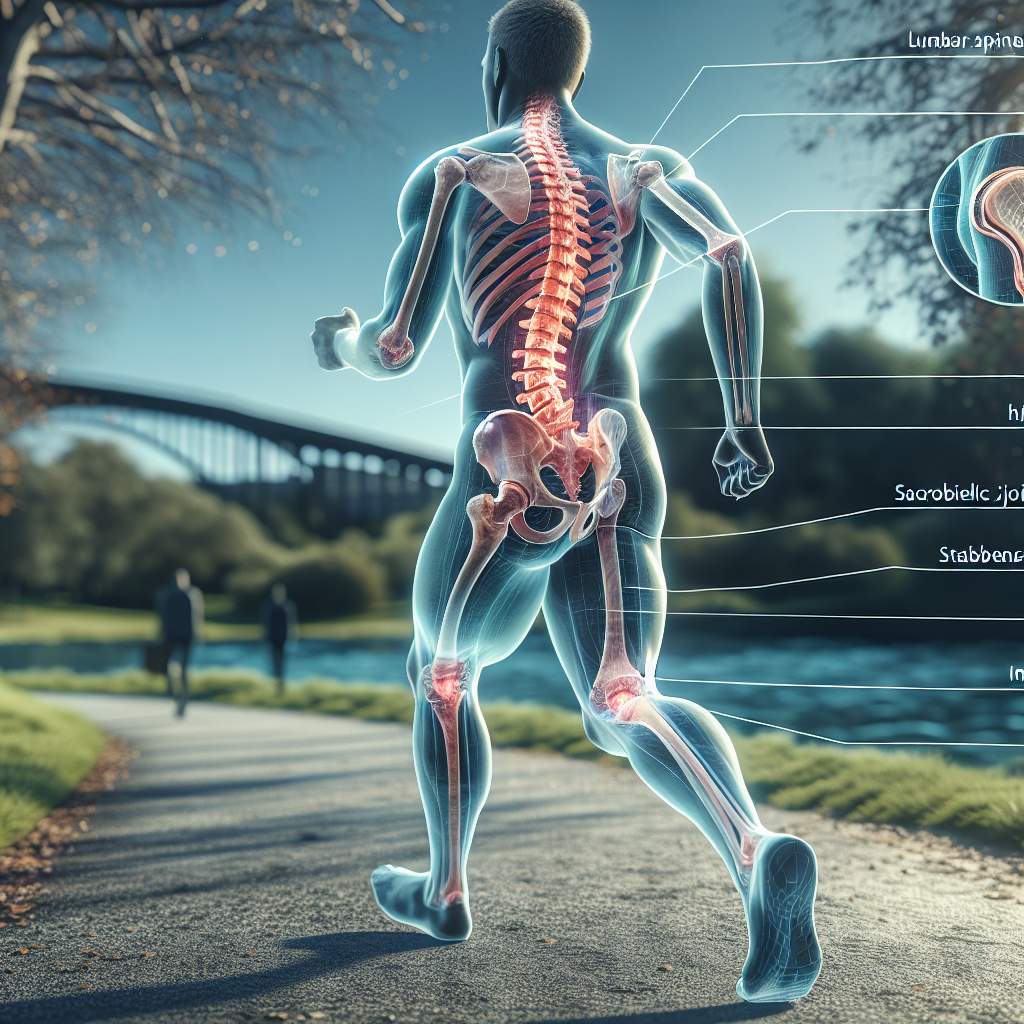
How Does Walking Influence Lumbar Spine And Sacroiliac Joint Health?
Have you ever wondered how something as simple as walking can impact the health of your lower back? Well, researchers have discovered that regular walking can have a positive influence on both the lumbar spine and sacroiliac joint health. By engaging in this low-impact exercise, the movement and weight-bearing involved can help strengthen the muscles around these areas, reducing the risk of pain and injury. Not only that, but walking also promotes blood circulation, which aids in the delivery of important nutrients and oxygen to the joints and discs, keeping them nourished and healthy. So, next time you lace up your shoes and head out for a stroll, remember that you’re not just getting some fresh air, you’re also giving your lower back a little extra love.

The Importance of Lumbar Spine and Sacroiliac Joint Health
The lumbar spine and sacroiliac joint are crucial components of the human body’s skeletal system. The lumbar spine consists of five vertebrae in the lower back, supporting the weight of the upper body and providing flexibility and stability. The sacroiliac joint connects the sacrum, or the triangular bone at the base of the spine, to the hip bones.
Understanding the Lumbar Spine and Sacroiliac Joint
The lumbar spine and sacroiliac joint play a vital role in supporting the body’s weight, maintaining balance, and facilitating movement. When these structures are healthy and functioning properly, they allow for efficient and pain-free mobility. However, various factors, such as poor posture, injury, or degenerative conditions, can lead to issues and pain in these areas.
Common Issues and Pain
Many individuals experience discomfort or pain in the lumbar spine and sacroiliac joint at some point in their lives. Common issues include muscle strains, ligament sprains, herniated discs, and arthritis. These conditions can cause localized pain, stiffness, reduced range of motion, and even radiating pain into the legs and buttocks.
Effects on Daily Life
Pain in the lumbar spine and sacroiliac joint can significantly impact an individual’s daily life. Simple activities like sitting, walking, or standing for extended periods may become challenging and painful. The discomfort can also affect sleep quality and overall mood, ultimately decreasing productivity and quality of life.
How Walking Can Benefit Lumbar Spine and Sacroiliac Joint
Walking is an excellent low-impact exercise that can provide numerous benefits for the lumbar spine and sacroiliac joint. Incorporating regular walking into your routine can contribute to the overall health and functioning of these structures.
Improving Joint Stability and Strength
Walking helps strengthen the muscles around the lumbar spine and sacroiliac joint, thus enhancing joint stability. The repetitive movement of walking engages and improves the strength of the core, buttock, and leg muscles, which provide support to these areas. Strengthening these muscles helps reduce the strain on the joints and minimizes the risk of injury.
Promoting Spinal Health
Regular walking promotes spinal health by improving posture and spinal alignment. Walking with the correct technique helps engage the muscles that support the spine, promoting proper alignment and reducing the risk of excessive pressure on the lumbar spine and sacroiliac joint. It also helps improve flexibility and range of motion in these areas.
Boosting Circulation and Nutrient Supply
Walking increases blood circulation throughout the body, including the lumbar spine and sacroiliac joint. Improved blood flow delivers essential nutrients and oxygen to these areas, aiding in the healing process and maintaining their overall health. Additionally, adequate blood flow helps remove waste products and toxins, reducing inflammation and alleviating discomfort.
Proper Walking Techniques to Promote Spinal Health
While walking can be beneficial for the lumbar spine and sacroiliac joint, it is essential to maintain proper techniques to maximize the benefits and minimize the risk of injury.
Maintaining Proper Posture
Good posture is crucial to ensure optimal spinal health while walking. Stand tall with your head aligned with your spine and your shoulders relaxed. Engage your core muscles by lightly pulling your belly button towards your spine. Avoid leaning forward or backward, as this can strain the lumbar spine and sacroiliac joint.
Engaging Core Muscles
To support the lumbar spine and sacroiliac joint during walking, it is important to engage the core muscles. Tighten your abdominal muscles slightly while maintaining a relaxed breathing pattern. This helps stabilize the spine and prevents excessive stress on the joints.
Finding the Right Stride and Step
Pay attention to your stride and step length. Take natural and comfortable steps, neither too short nor too long. Allow your heel to make initial contact with the ground, and smoothly transfer your weight from the heel to the ball of your foot as you push off for the next step. Be mindful of maintaining a smooth and even gait to avoid placing unnecessary stress on the lumbar spine and sacroiliac joint.
Walking Frequency and Duration for Optimal Benefits
In order to experience the full benefits of walking for lumbar spine and sacroiliac joint health, it is important to establish an appropriate walking frequency and duration.
Recommended Frequency of Walking
Experts recommend walking for at least 30 minutes a day, five days a week, to maintain overall health. However, individuals with specific lumbar spine and sacroiliac joint issues may benefit from shorter, more frequent walks spread throughout the day. Gradually increase the duration and intensity of your walks as your fitness level improves.
Ideal Duration per Walking Session
Each walking session should ideally last for 30 minutes. However, if you are a beginner or experiencing discomfort, start with shorter durations, such as 10-15 minutes, and gradually increase as tolerated. Remember to listen to your body and adjust the duration accordingly to avoid overexertion and strain.
Progression and Gradual Increase
To prevent overuse injuries and allow your body to adapt gradually, it is important to progress slowly when increasing the frequency and duration of your walks. Increase your walking time by small increments, such as 5-10 minutes per week, to allow your muscles and joints to adapt and strengthen effectively.

Walking Surfaces and Environments for Joint Health
Choosing the right walking surfaces and environments can significantly impact the health of your lumbar spine and sacroiliac joint.
Choosing Suitable Walking Surfaces
Opt for even and flat surfaces for a safe and comfortable walking experience. Paved sidewalks, asphalt roads, or well-groomed trails are ideal choices. These surfaces provide stability and minimize the risk of slips, falls, or uneven stress on the joints. If you prefer walking indoors, consider using a treadmill with a cushioned surface to absorb impact effectively.
Avoiding Uneven or Slippery Terrain
Avoid walking on uneven surfaces, such as rocky trails or uneven pavement, as they can increase the risk of falls and joint instability. Similarly, be cautious of walking on slippery surfaces, especially during wet or snowy conditions, as it can lead to accidental falls and injuries. Safety should always be a priority when selecting your walking environments.
Climate Considerations
Extreme weather conditions, such as excessive heat or cold, can affect the lumbar spine and sacroiliac joint. In hot weather, choose cooler times of the day for your walks or consider indoor options. In cold weather, ensure that you adequately layer clothing to keep your body warm and maintain joint flexibility. Stay hydrated and make appropriate modifications to your walking routine based on the climate conditions to optimize joint health.
The Role of Footwear in Lumbar Spine and Sacroiliac Joint Health
Choosing the right footwear is crucial for maintaining optimal lumbar spine and sacroiliac joint health during walking.
Importance of Supportive Shoes
Supportive shoes provide stability and cushioning, which is essential for minimizing the impact on the lumbar spine and sacroiliac joint. They help in maintaining proper foot alignment and absorbing shock, reducing the stress on these areas. Investing in well-fitting, quality walking shoes with sufficient arch support can make a significant difference in the comfort and health of your joints.
Choosing the Right Shoe
When selecting walking shoes, look for features like adequate arch support, cushioning, and a flexible sole. Ensure that the shoes fit properly with enough room for your toes to move comfortably. Visit a specialized shoe store to get professional advice and assistance in finding the right shoe that suits your feet and walking style.
Orthotic Inserts and Other Considerations
If you have specific foot or gait abnormalities, or if you require additional support, consider using orthotic inserts. These custom-made or over-the-counter inserts can help correct any biomechanical imbalances and provide additional cushioning and support to the lumbar spine and sacroiliac joint during walking. Consult with a podiatrist or orthopedic specialist to determine if orthotic inserts are suitable for you.

How Does Walking Influence Lumbar Spine And Sacroiliac Joint Health?
Supplementary Exercises to Complement Walking
While walking provides a multitude of benefits for the lumbar spine and sacroiliac joint, incorporating supplementary exercises can further enhance their health and function.
Strengthening Core Muscles
Strong core muscles provide stability and support to the lumbar spine and sacroiliac joint. Including exercises that target the core, such as planks, abdominal crunches, and bridges, can help improve muscle strength and reduce strain on these areas. Consult with a fitness professional or physical therapist for a customized core strengthening program appropriate for your fitness level and specific needs.
Stretching and Flexibility Exercises
Stretching exercises can help maintain flexibility in the muscles and joints surrounding the lumbar spine and sacroiliac joint. Incorporate gentle stretches for the lower back, hips, hamstrings, and hip flexors into your routine. Ensure that you perform these stretches after adequate warm-up or as recommended by a healthcare professional to avoid injury.
Balance and Stability Training
Enhancing balance and stability can further improve the function and protection of the lumbar spine and sacroiliac joint. Include exercises that challenge your balance, such as single-leg stands or yoga poses, to strengthen the muscles responsible for stability. Gradually progress to more challenging exercises as your balance and stability improve.
Preventing and Alleviating Pain during Walking
While walking is generally a low-impact exercise, it is important to take precautions to prevent and alleviate pain in the lumbar spine and sacroiliac joint.
Proper Warm-up and Cool Down
Before beginning your walking routine, warm up your muscles and joints with dynamic stretches or light cardio exercises. This helps increase blood flow and prepares your body for the activity. After walking, cool down with static stretches to improve flexibility and prevent post-exercise muscle tightness.
Avoiding Overexertion and Strain
Listen to your body and avoid overexertion or pushing through pain while walking. Start with a comfortable pace and gradually increase as you build endurance. Pay attention to any signs of strain or discomfort and modify your routine accordingly. If you experience pain that persists or worsens, consult with a healthcare professional for proper diagnosis and guidance.
Modifying Walking Routine for Pain Relief
If you experience mild discomfort or pain during walking, consider making modifications to your routine. Shorten your stride, reduce the duration, or choose a more level walking surface to minimize stress on the lumbar spine and sacroiliac joint. Additionally, applying heat or cold therapy to the affected areas before or after walking can help reduce pain and inflammation.

Professional Guidance for Addressing Lumbar Spine and Sacroiliac Joint Issues
If you are experiencing chronic pain or significant limitations in the lumbar spine and sacroiliac joint, it is advisable to seek professional guidance for a comprehensive approach to treatment and management.
Consulting with a Physical Therapist
Physical therapy can provide targeted exercises and techniques to improve the strength, flexibility, and function of the lumbar spine and sacroiliac joint. A physical therapist can assess your specific condition, identify contributing factors, and develop a customized treatment plan to address your individual needs.
Chiropractic Care and Spinal Manipulation
Chiropractors specialize in addressing musculoskeletal conditions, including those affecting the lumbar spine and sacroiliac joint. Chiropractic adjustments and spinal manipulations can help alleviate pain, improve joint mobility, and restore proper alignment. Consult with a qualified chiropractor to determine if this approach is suitable for your condition.
Other Healthcare Professionals
In certain cases, it may be necessary to consult with other healthcare professionals, such as orthopedic specialists, rheumatologists, or pain management specialists, for a multidisciplinary approach to managing lumbar spine and sacroiliac joint issues. They can provide advanced diagnostics, medication management, or other interventions to address complex or severe conditions.
Conclusion
Walking is a simple yet effective way to promote the health of the lumbar spine and sacroiliac joint. By improving joint stability and strength, promoting spinal health, and boosting circulation and nutrient supply, walking offers numerous benefits for these crucial areas. Understanding proper walking techniques, frequency, and duration, as well as selecting suitable walking surfaces and footwear, will enhance the positive impact on the lumbar spine and sacroiliac joint. By complementing walking with supplementary exercises and seeking professional guidance when needed, you can incorporate this low-impact exercise into a healthy lifestyle that supports and maintains optimal lumbar spine and sacroiliac joint health.









